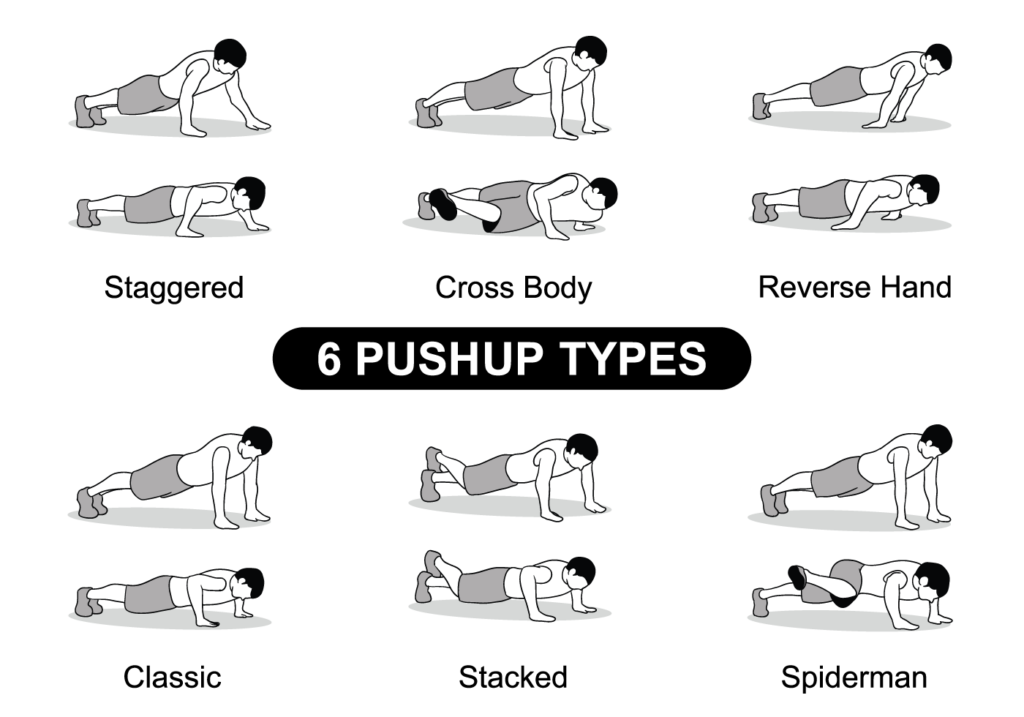How Push-Ups Boost Health: Push-ups are often seen as a simple yet powerful exercise that can be done anywhere, anytime, without fancy equipment. Despite their simplicity, push-ups pack a punch regarding health benefits. From building upper body strength to improving cardiovascular health, push-ups are versatile and effective exercises that can enhance overall fitness.
This article delves into the key benefits of push-ups and explains why this classic exercise should be a staple in your fitness routine.
Physical Health Benefits
Muscle Strength and Hypertrophy

Push-ups are a compound exercise that targets multiple muscle groups simultaneously, making them highly effective for building strength and promoting muscle hypertrophy. The primary muscles engaged during a push-up include the chest (pectoralis major), shoulders (deltoids), triceps, core muscles (including the rectus abdominis and obliques), and the back (specifically the trapezius and rhomboids).
As you lower your body, these muscles stabilize and move your body weight, increasing strength and muscle growth over time. Incorporating push-ups into your routine can significantly contribute to overall strength development, especially in the upper body, while promoting muscle hypertrophy through consistent resistance training.
Endurance and Stamina

Push-ups are crucial for building muscle and improving endurance and stamina. As you perform push-ups regularly, your muscles adapt to the repeated effort, becoming more efficient at sustaining activity over time.
This improved endurance benefits both aerobic and anaerobic exercises. It allows you to perform better in activities that require prolonged exertion, such as running or cycling, as well as short bursts of high-intensity effort, like sprinting or weightlifting. The gradual increase in stamina from push-ups can enhance your overall physical performance, making daily activities and workouts more manageable.
Flexibility and Mobility

In addition to strength and endurance, push-ups can positively impact your flexibility and joint mobility. Properly executed push-ups require a full range of motion at the shoulders, elbows, and wrists, which helps maintain and improve joint flexibility over time.
Maintaining correct form, posture, and alignment during push-ups is crucial to maximizing these benefits and preventing injury.
Cardiovascular Health

Push-ups can also contribute to cardiovascular health, especially when performed at a moderate to high intensity. The sustained effort required to complete multiple push-ups in succession increases your heart rate, promoting better circulation and cardiovascular endurance.
While push-ups may not offer the same cardiovascular benefits as running or swimming, they still provide a valuable form of aerobic exercise, particularly when incorporated into a high-intensity interval training (HIIT) routine.
Compared to other forms of aerobic exercise, push-ups offer the added benefit of simultaneously building strength, making them a well-rounded addition to any fitness program focused on heart health and overall conditioning.
Mental Health Benefits
Stress Reduction
Physical activity is a proven method for stress reduction, and push-ups are no exception. The rhythmic movement and focus required for proper form can serve as a form of mindfulness, diverting attention from stressors. Regular push-up routines can help lower cortisol levels, the hormone associated with stress, promoting a sense of calm and relaxation.
Mood Improvement
Push-ups contribute to mood enhancement by stimulating the release of endorphins, often called “feel-good” hormones. These natural mood elevators can help alleviate symptoms of depression and anxiety. Additionally, achieving fitness goals through consistent push-up challenges can boost self-esteem and well-being.
Mental Clarity and Focus
Regular exercise, including push-ups, has been linked to improved cognitive function. Physical activity increases blood flow to the brain, providing essential nutrients and oxygen. This enhanced brain function can improve focus, concentration, and mental clarity. Long-term adherence to a push-up routine can contribute to sustained mental health benefits, including reduced risk of cognitive decline.
Exercise Variations for Enhanced Benefits

Standard Push-Ups
Standard push-ups are the most common variation and form the foundation of push-up exercises. They involve placing your hands shoulder-width apart on the ground, keeping your body straight from head to heels, and lowering yourself until your chest almost touches the floor before pushing back up. This basic technique effectively engages the chest, shoulders, and triceps while working the core for stability.
Modified Push-Ups
Modified push-ups are excellent for beginners or individuals with limited upper body strength.
- Knee push-ups: Start in a push-up position but rest your knees on the ground. This reduces the body weight supported by your arms, making it easier to perform.
- Inclined push-ups (beginner): Perform push-ups with your hands on a stable surface like a table or chair. The higher the surface, the easier the exercise.
- Wall push-ups: Stand facing a wall, arms extended, and hands flat against the wall. Bend your elbows and move your body towards the wall to perform push-ups.
As you gain strength, gradually decrease the incline or elevation to progress to more challenging variations.
Incline and Decline Push-Ups
These variations target different muscle groups and offer increased challenge.
- Incline push-ups (intermediate): Elevate your hands on a bench or step to increase the angle of your body. This variation places more emphasis on the upper chest and shoulders.
- Decline push-ups (advanced): Elevate your feet on a bench or step to increase the angle of your body. This variation targets the lower chest and triceps more intensively.
Practical Implementation
Incorporating Push-Ups into Your Fitness Routine
To effectively integrate push-ups into your fitness routine, incorporate them into your daily or weekly workouts. For beginners, aim to perform push-ups 2-3 times per week, gradually increasing the frequency as strength and endurance improve. You can include push-ups in your routine as a standalone or full-body workout.
For variety, mix push-up variations to target different muscle groups and prevent plateaus. To maintain consistency, schedule specific times for your push-up workouts and set reminders to stay on track.
Setting Fitness Goals
Setting realistic and achievable fitness goals is crucial for long-term success with push-ups. Begin by establishing short-term goals, such as completing a certain number of push-ups in a set or mastering a specific push-up variation.
Long-term goals include increasing your overall push-up count or improving form and technique. To track progress effectively, ensure your goals are specific, measurable, and time-bound.
Monitoring Progress
Tracking your progress with push-ups helps measure improvements and stay motivated. Record the number of sets and repetitions completed in each workout, and note any variations or modifications used. Over time, monitor changes in your ability to perform push-ups, such as increased volume or improved form.
A workout log or fitness app can help you visualize progress and set new benchmarks. Regularly reviewing your progress allows you to celebrate achievements and adjust your routine as needed to continue making gains.
Injury Prevention and Safety Tips
Proper Technique
Maintaining proper technique during push-ups is essential to avoid injury and maximize benefits. Key elements of the proper technique include:
- Hand Placement: Position your hands slightly wider than shoulder-width apart to distribute weight and engage the correct muscles evenly.
- Body Alignment: Keep your body straight from head to heels, avoiding sagging in the lower back or raising your hips too high.
- Elbow Position: Keep your elbows at a 45-degree angle to your body to reduce strain on the shoulders and wrists.
- Range of Motion: Lower yourself until your chest almost touches the ground, ensuring a full range of motion for optimal muscle engagement.
By focusing on these elements, you can perform push-ups safely and effectively, minimizing the risk of injury.
Joint Health
Ensuring good joint health is crucial for reducing the risk of injury during push-ups. Here are some tips for maintaining joint health:
- Warm-Up: Always thoroughly warm up before doing push-ups to prepare your muscles and joints for exercise. Include dynamic stretches and mobility exercises targeting the shoulders, wrists, and elbows.
- Progress Gradually: Increase the intensity and volume of your push-ups gradually.
Metabolic Impact
Push-ups contribute to calorie burn and weight management by engaging multiple muscle groups and requiring significant energy expenditure. The number of calories burned during push-ups depends on factors such as your body weight, intensity of the exercise, and duration.
By incorporating push-ups into your routine, you can increase your overall calorie expenditure, which supports weight management and fat loss. Consistent push-ups, combined with a balanced diet and other forms of exercise, can contribute to achieving and maintaining a healthy weight.
As a resistance exercise, push-ups stimulate muscle growth, which requires more energy than fat tissue. This increased muscle mass can elevate your resting metabolic rate, leading to higher calorie burn even at rest.
Overall Wellbeing
Push-ups offer a comprehensive boost to overall well-being. Physically, they enhance strength, endurance, and bone health. Proper form contributes to improved posture and balance. As a weight-bearing exercise, push-ups can aid in weight management. Moreover, they help prevent injuries by strengthening core and upper body muscles.
Mentally, push-ups provide a multitude of benefits. The rhythmic motion can serve as a stress reliever, while the release of endorphins uplifts mood. Building strength through push-ups contributes to increased self-esteem.
Additionally, this exercise enhances cognitive function by increasing blood flow to the brain. Regular push-up practice can ultimately improve sleep quality, culminating in a greater sense of overall well-being.
Frequently Asked Questions
What are the main muscle groups targeted by push-ups?
Push-ups primarily target the chest, shoulders, triceps, core muscles, and the back).
How do push-ups contribute to muscle strength and hypertrophy?
Push-ups help build muscle strength and promote hypertrophy by engaging multiple upper-body muscles simultaneously. The resistance from your body weight causes muscle fibers to tear and repair, increasing muscle size and strength.
How do push-ups impact flexibility and mobility?
Push-ups can improve flexibility and joint mobility by requiring a full range of motion at the shoulders, elbows, and wrists. Proper form and alignment are crucial for maximizing these benefits.





